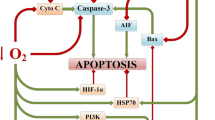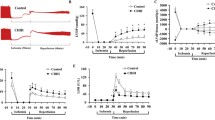We studied the expression of chaperone GRP-78 and transcription factor NF-kB during the development of ischemic tolerance of the brain after combined and isolated exposure to hypoxia and hypercapnia. Combined exposure to hypoxia and hypercapnia maximally increased the expression of chaperone GRP-78 and transcription factor NF-kB, while the formation of ischemia-induced tolerance under conditions of hypercapnic hypoxia can be associated with activation of adaptive stress mechanisms in the endoplasmic reticulum. Under these conditions, hypercapnia in combination with hypoxia is a priority factor for activation of GRP-78 and transcription factor NF-kB.
Similar content being viewed by others
References
Bespalov AG, Tregub PP, Kulikov VP, Pijanzin AI, Belousov AA. The role of VEGF, HSP-70 and protein S-100B in the potentiation effect of the neuroprotective effect of hypercapnic hypoxia. Patol. Fiziol. Eksper. Ter. 2014:(2):24-27. Russian.
Tregub PP, Kulikov VP, Rucheikin NYu, Belova EV, Motin YuG. Proliferative and Synthetic Activity of Nerve Cells after Combined or Individual Exposure to Hypoxia and Hypercapnia. Bull Exp Biol Med. 2015:159(3):334-336.
Abramoff MD, Magelhaes PJ, Ram SJ. Image Processing with ImageJ. Biophotonics International. 2004:11(7):36-42.
Chen F, Suzuki Y, Nagai N, Peeters R, Sun X, Coudyzer W, Marchal G, Ni Y. Rat cerebral ischemia induced with photochemical occlusion of proximal middle cerebral artery: a stroke model for MR imaging research. MAGMA. 2004:17(3-6):103-108.
Dickhout JG, Krepinsky JC. Endoplasmic reticulum stress and renal disease. Antioxid. Redox Signal. 2009:11(9):2341-2352.
Kaneko M, Niinuma Y, Nomura Y. Activation signal of nuclear factor-kappa B in response to endoplasmic reticulum stress is transduced via IRE1 and tumor necrosis factor receptorassociated factor 2. Biol. Pharm. Bull. 2003:26(7):931-935.
Kitamura M. Endoplasmic reticulum stress and unfolded protein response in renal pathophysiology: Janus faces. Am. J. Physiol. Renal Physiol. 2008:295(2):F323-F334.
Neckár J, Papousek F, Nováková O, Ost’ádal B, Kolár F. Cardioprotective effects of chronic hypoxia and ischaemic preconditioning are not additive. Basic Res. Cardiol. 2002:97(2):161-167.
Ostergaard L, Simonsen U, Eskildsen-Helmond Y, Vorum H, Uldbjerg N, Honoré B, Mulvany MJ. Proteomics reveals lowering oxygen alters cytoskeletal and endoplasmatic stressproteins in human endothelial cells. Proteomics. 2009:9(19):4457-4467.
Pevsner PH, Eichenbaum JW, Miller DC, Pivawer G, Eichenbaum KD, Stern A, Zakian KL, Koutcher JA. A photothrombotic model of small early ischemic infarcts in the rat brain with histologic and MRI correlation. J. Pharmacol. Toxicol. Methods. 2001:45(3):227-233.
Rybnikova E, Gluschenko T, Tulkova E, Churilova A, Jaroshevich O, Baranova K, Samoilov M. Preconditioning induces prolonged expression of transcription factors pCREB and NFkappa B in the neocortex of rats before and following severe hypobaric hypoxia. J. Neurochem. 2008:106(3):1450-1458.
Tao T, Liu Y, Zhang J, Xu Y, Li W, Zhao M. Therapeutic hypercapnia improves functional recovery and attenuates injury via antiapoptotic mechanisms in a rat focal cerebral ischemia/reperfusion model. Brain Res. 2013:1533):52-62.
Tregub P, Kulikov V, Motin Y, Bespalov A, Osipov I. Combined exposure to hypercapnia and hypoxia provides its maximum neuroprotective effect during focal ischemic injury in the brain. J. Stroke Cerebrovasc. Dis. 2015:24(2):381-387.
Zhan L, Wang T, Li W, Xu Z.C, Sun W, Xu E. Activation of Akt/FoxO signaling pathway contributes to induction of neuroprotection against transient global cerebral ischemia by hypoxic preconditioning in adult rats. J. Neurochem. 2010:114(3):897-908.
Zhang K, Kaufman RJ. From endoplasmic-reticulum stress to the inflammatory response. Nature. 2008:454:455-462.
Author information
Authors and Affiliations
Corresponding author
Additional information
Translated from Byulleten’ Eksperimental’noi Biologii i Meditsiny, Vol. 161, No. 4, pp. 457-461, April, 2016
Rights and permissions
About this article
Cite this article
Tregub, P.P., Kulikov, V.P., Motin, Y.G. et al. Stress of the Endoplasmic Reticulum of Neurons in Stroke Can Be Maximally Limited by Combined Exposure to Hypercapnia and Hypoxia. Bull Exp Biol Med 161, 472–475 (2016). https://doi.org/10.1007/s10517-016-3441-z
Received:
Published:
Issue Date:
DOI: https://doi.org/10.1007/s10517-016-3441-z




